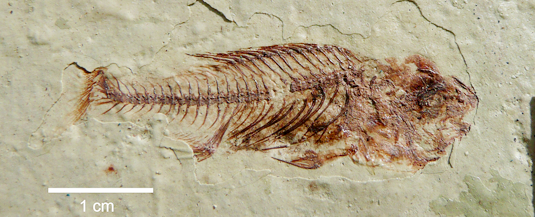Trove of fish fossils discovered
A research team led by LMU paleontologist Bettina Reichenbacher has uncovered a rich trove of fossil fish in the Rift Valley in Kenya. The new specimens promise to reveal important details of the evolutionary history of freshwater fish in Africa.
14.03.2013

All the visitor sees now is sedimentary rock and scree. But long ago, this was a watery landscape teeming with fish. Paleontologist Professor Bettina Reichenbacher and her colleagues have recently discovered assemblages of fossil fish at no less than eight previously unknown localities in the Tugen Hills Range in Western Kenya. “Not only is it very rare to uncover so many specimens of fossil fish, those we have found are also very well preserved,” says Reichenbacher, who is a member of the Paleontology and Geobiology Section of the Department of Earth and Environmental Sciences at LMU.
The fossil finds, dated to between 10 and 12 million years ago, will spend the coming 2 years in Munich. A collaboration agreement concluded with Egerton University (Nakuru, Kenya) allows the Munich researchers to bring the material to Germany temporarily for detailed study. The fossils are now stored in an old wooden cabinet and, as Bettina Reichenbacher opens each drawer, the imprint of the million years-old animals is clearly distinguishable from the variously shaded rock matrix in which they have been trapped for so long. Some specimens have been preserved complete. Others are fragmentary, and only heads, fins or other skeletal elements can be discerned. However, that diverse species are represented in the collection is readily apparent even to the non-expert observer. Picking up one of the fossils at random, paleontologist Reichenbacher identifies it as – “a cichlid”. The chances are that systematic investigation of the material recovered will identify many species previously unknown to science.
Some 3000 species of freshwater fish are known to inhabit the river systems and lakes of modern Africa. However, this diversity is not reflected in the known fossil record. So far, less than 60 fossil species have been described from the continent, partly because most of the finds consist of isolated teeth and bones. “Further investigation of the fossils we have found will provide us with valuable information about the evolution of the fish fauna not only in Kenya, but in the whole of East Africa,” says Bettina Reichenbacher.
Miocene landscapes
Fossils are indispensable sources of evidence for those wishing to trace the course of biological evolution. However, paleontologists are not only interested in reconstructing the detailed anatomy of extinct species, their finds also reveal a great deal about the ecological and climatic conditions under which ancient organisms lived. “For instance, we can tell whether these fish lived in tropical lakes or in drier habitats that were subject to periodic droughts,” says Bettina Reichenbacher. This kind of information will help researchers pinpoint the onset of dry conditions in the Middle Miocene, when tropical forests were gradually being replaced by open grassland with less tree cover. This is of great interest, as the transformation of woodland into savannah is thought to have favored the diversification of hominids, the evolutionary lineage to which modern humans belong.
The section of the Rift Valley that lies within the boundaries of modern Kenya is sometimes referred to as “the cradle of mankind”, because palaeontologists and anthropologists have excavated some of the most important hominid fossils here, including close relatives of our own lineage.
“We assume that the fish succumbed to the effects of volcanic activity. The jaws of many individuals are agape, which suggests that they were asphyxiated,” says Bettina Reichenbacher. Volcanism could also account for their good state of preservation. They may have been rapidly buried under layers of volcanic ash, which would have protected them from early post-mortem decay and later from the ravages of erosion.
The lifestyles of the fossil fishes
The mountains of the Tugen Hills Range, in which the fossils were discovered, is in large part a trackless waste. In the course of their expedition in this difficult terrain, the researchers received invaluable support from the Orrorin Community Organisation, a local association devoted to promoting the exploration of the region’s rich paleontological heritage.
At the find-spots located by the research team, the overlying sediments had to be carefully removed to allow the fossil-bearing horizons to be recovered for scientific study. The rock slabs containing the fossils were subjected to immediate conservation treatment on site by an expert from the Bavarian State Collections for Paleontology and Geology.
Bettina Reichenbacher and her team have just returned home from their excursion to Kenya, which was made possible by a grant from the Deutsche Forschungsgemeinschaft. The detailed examination of the fossil material is just beginning. This will involve a thorough analysis of the morphology of each of the specimens – “quite comparable to a criminological investigation,” says Bettina Reichenbacher – which will allow the researchers to clarify their relationships with modern species and reconstruct their lifestyles. Thus, the reward for all this work will be a clear picture of the species diversity and the living conditions in the aquatic ecosystems of the Tugen Hills region in Miocene times, around 10 million years ago.





